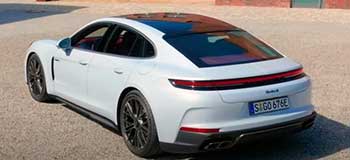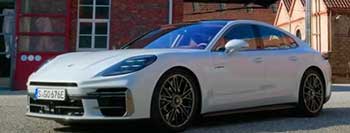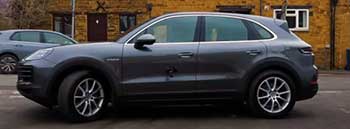
I’ve always been drawn to Porsche’s blend of performance and luxury, and choosing between the Panamera and Cayenne felt like picking a favorite song from a perfect album.
Both vehicles embody Porsche’s sporty DNA, but they cater to different lifestyles—one a sleek sedan, the other a commanding SUV.
My goal here is to share my hands-on experience with both, weighing their pros and cons, and helping you decide which fits your needs.
With a comparison table, detailed insights, and practical tips, I’ll break down what makes each car shine and where they fall short.
Comparison Table
| Feature | Porsche Panamera | Porsche Cayenne |
|---|---|---|
| Body Style | Sedan/Hatchback | SUV |
| Base Price | $104,795 | $80,850 |
| Engine (Base) | 2.9L V6, 349 hp | 3.0L V6, 348 hp |
| 0-60 mph (Base) | 5.3 seconds | 5.7 seconds |
| Transmission | 8-speed PDK | 8-speed Tiptronic S |
| Fuel Economy (Base) | 20 mpg combined | 18 mpg combined |
| Cargo Space | 17.6 cu.ft. (500L) | 27.2 cu.ft. (770L) |
| Ground Clearance | 5.3 in (135 mm) | 8.3 in (210 mm) |
| Seating Capacity | 4 (5 optional) | 5 |
| Drive Type | AWD (RWD optional) | AWD |
| Infotainment | 12.3-in touchscreen, Apple CarPlay | 12.3-in touchscreen, Apple CarPlay |
| Safety Features | Lane Keep Assist, AEB, ParkAssist | Adaptive Cruise Control, AEB, ParkAssist |
My Experience With The Porsche Panamera
Driving the Porsche Panamera feels like piloting a sports car that somehow grew four doors and a luxurious interior. The first time I slid into its low-slung driver’s seat, I was struck by how it hugs the road, almost daring me to push its limits.
The Panamera’s sleek design and razor-sharp handling make every twisty road a playground. I took a 2024 Panamera G3 out for a spin, and its 349-hp V6 paired with the 8-speed PDK transmission delivered seamless power. Accelerating from 0 to 60 mph in 5.3 seconds felt effortless, and the optional rear-axle steering made tight corners feel like a dance.
Inside, the Panamera’s cabin is a tech lover’s dream. The 12.3-inch touchscreen is crisp, and the optional 10.9-inch passenger display let my co-driver stream a movie without distracting me.
The seats, adjustable up to 14 ways, cradled me perfectly during long drives. However, parking in tight city spots was a challenge due to its 1937 mm width and low seating position, which made judging corners tricky. The 500-liter boot was decent for groceries or weekend bags, but don’t expect to haul bulky cargo.
The Panamera’s sporty soul shines on highways or backroads, but it’s less practical for family duties. I took it on a cross-country trip, and while the ride was exhilarating, the limited rear legroom made my taller passengers grumble.
Fuel economy hovered around 20 mpg combined, which isn’t bad for a performance sedan, but it’s not winning any efficiency awards. Overall, the Panamera feels like a 911 with extra seats—perfect for those who prioritize driving thrills over utility.
My Experience With The Porsche Cayenne
The Porsche Cayenne, on the other hand, feels like a luxury fortress on wheels. My test drive in a 2025 Cayenne Base model revealed why it’s a favorite among SUV enthusiasts.
Its 348-hp V6 engine, paired with an 8-speed Tiptronic S transmission, hit 60 mph in 5.7 seconds—not as quick as the Panamera, but plenty peppy for an SUV. The higher seating position gave me a commanding view of the road, and the adaptive air suspension (optional on the base model) smoothed out bumpy terrain like a magic carpet.
The Cayenne’s interior is spacious and practical, with 770 liters of cargo space that easily swallowed my camping gear. The rear seats offered ample legroom, making it a better choice for family outings.
I loved the intuitive Porsche Communication Management system, which synced effortlessly with my phone via Apple CarPlay. Parking was a breeze, thanks to the higher ground clearance (210 mm) and standard self-steering ParkAssist, which handled tight spots better than I could.
However, the Cayenne’s heft—2840 kg in some trims—made it feel less agile than the Panamera on winding roads. Its fuel economy, around 18 mpg combined, was slightly worse than the Panamera’s.
I also noticed the base model’s 20-inch wheels looked a bit underwhelming; upgrading to 22-inch rims added visual flair but stiffened the ride. The Cayenne excels as a versatile daily driver, blending luxury, space, and enough performance to keep things exciting.
Pros Of The Porsche Panamera

- Sporty Handling: The Panamera’s low center of gravity and optional rear-axle steering make it corner like a sports car, offering precision that’s rare for a sedan.
- Powerful Performance: Even the base 2.9L V6 delivers 349 hp, and higher trims like the Turbo S E-Hybrid push past 700 hp, hitting 60 mph in just 3.3 seconds.
- Luxurious Interior: The cabin feels like a high-tech cockpit with premium materials, a 12.3-inch touchscreen, and optional 14-way adjustable seats for ultimate comfort.
- Advanced Technology: Features like wireless Apple CarPlay, an optional passenger display, and Porsche Active Ride suspension elevate the driving experience.
- Fuel Efficiency (Hybrids): The Panamera S E-Hybrid offers up to 20 miles of electric range and 76 mpg combined, making it a greener choice for performance fans.
- Customization Options: Porsche’s extensive configurator lets you tailor everything from paint to wheel size, ensuring a unique ride.
The Panamera’s strengths lie in its ability to blend sports car dynamics with sedan practicality. I was blown away by how planted it felt during aggressive cornering, thanks to its all-wheel-drive system and adaptive suspension. The hybrid models impressed me with their efficiency, especially for city commutes. The interior’s attention to detail, like the soft leather steering wheel and ambient lighting, made every drive feel special. If you’re after a car that prioritizes driving excitement and luxury over raw utility, the Panamera delivers in spades.
Read more: My Thoughts on Acura Integra Vs. Honda Accord
Cons Of The Porsche Panamera
- Limited Cargo Space: With only 500 liters of boot space, the Panamera struggles with bulky items compared to SUVs like the Cayenne.
- Tight Rear Legroom: The back seats feel cramped for taller passengers, making it less ideal for family trips or chauffeuring duties.
- High Price Tag: Starting at $104,795, it’s pricier than the Cayenne, and options like the Sport Chrono package can push costs well over $150,000.
- Low Ground Clearance: At 135 mm, the Panamera scrapes on steep driveways or rough roads, limiting its versatility.
- Complex Infotainment: The touchscreen-heavy interface can feel overwhelming, especially when adjusting settings on the go.
- Parking Challenges: Its wide body and low seating position make maneuvering in tight spaces trickier than in the Cayenne.
The Panamera’s sporty design comes with trade-offs. I found the rear seats cramped during a road trip with friends, and the boot couldn’t handle larger luggage without folding seats. The low ground clearance scraped on a steep driveway, which was frustrating. The infotainment system, while sleek, took some getting used to, as touch controls felt less intuitive than physical buttons. Cost is another hurdle—adding premium features like Burmester audio or carbon-ceramic brakes skyrockets the price, making it a tough sell for budget-conscious buyers.
Pros Of The Porsche Cayenne

- Spacious Cargo Area: The 770-liter boot easily handles large loads, from groceries to sports equipment, making it ideal for family adventures.
- Versatile Performance: With 348 hp in the base model and up to 729 hp in the Turbo E-Hybrid, the Cayenne balances power and practicality.
- Higher Ground Clearance: At 210 mm, it tackles uneven terrain or snow better than the Panamera, boosting off-road capability.
- Comfortable Cabin: Roomy rear seats and adjustable front seats (up to 18-way) ensure comfort for all passengers on long drives.
- Advanced Safety Features: Standard self-steering ParkAssist and optional adaptive cruise control make driving and parking stress-free.
- Family-Friendly Design: Five seats and ISOFIX mounts make it a practical choice for parents or those needing extra space.
The Cayenne’s versatility won me over during a weekend camping trip. Its cargo space swallowed tents and coolers with room to spare, and the higher ride height made navigating dirt roads a non-issue. The cabin felt airy, and my passengers appreciated the legroom. Safety tech like the 360-degree camera and adaptive cruise control made highway drives relaxing. Even in base form, the Cayenne’s performance kept me grinning, and its ability to tow trailers or haul gear makes it a true all-rounder.
Cons Of The Porsche Cayenne
- Less Agile Handling: Its 2840 kg weight and higher center of gravity make it feel less nimble than the Panamera on tight corners.
- Lower Fuel Economy: At 18 mpg combined, it’s less efficient than the Panamera, especially in non-hybrid trims.
- Base Model Styling: The standard 20-inch wheels look underwhelming, and upgrades to larger rims can compromise ride comfort.
- Expensive Options: While cheaper than the Panamera at $80,850, extras like air suspension or premium audio quickly inflate the price.
- Stiffer Ride (Base): Without adaptive suspension, the base Cayenne feels firmer over bumps compared to the Panamera.
- Less Sporty Vibe: Despite strong performance, it lacks the sedan’s low-slung, sports-car-like driving dynamics.
The Cayenne’s heft was noticeable when I pushed it through winding roads—it’s capable but doesn’t match the Panamera’s razor-sharp handling. Fuel stops were more frequent, especially in city driving, and the base model’s styling felt a bit plain without pricier wheel upgrades. The ride quality on standard suspension was jarring over potholes, and adding options like air suspension pushed costs closer to the Panamera’s territory. If you crave pure driving thrills, the Cayenne might feel like a compromise despite its strengths.
Maintenance Tips For The Porsche Panamera
- Regular Oil Changes: Change the oil every 10,000 miles or annually using Porsche-approved synthetic oil to keep the engine running smoothly.
- Transmission Fluid Checks: Service the PDK transmission every 40,000 miles to prevent harsh shifts or clutch wear, which can cost $3,000-$5,000 to repair.
- Tire Maintenance: Rotate tires every 5,000 miles and monitor pressure, as the Panamera’s low-profile tires (e.g., 275/40 R20) wear quickly under aggressive driving.
- Cooling System Care: Replace the water pump and hoses proactively at 60,000 miles to avoid leaks, which can lead to costly engine damage.
- Battery Health: Use a trickle charger for infrequent use, and replace the battery every 4-5 years to prevent electronic issues.
- Brake Inspections: Check brake pads every 15,000 miles, as spirited driving can wear them faster, with replacements costing $800-$1,500.
- Porsche Specialist: Always use a certified Porsche mechanic for repairs to ensure proper diagnostics and factory parts, avoiding generic shop errors.
Maintaining a Panamera requires diligence, but it pays off. I learned the hard way that skipping oil changes can stress the V6 or V8 engines, leading to sluggish performance. The PDK transmission is a gem but needs regular fluid changes to avoid expensive repairs. Low-profile tires look great but wear out fast if you love cornering, so I rotate mine religiously. Proactive water pump replacement saved me from a potential breakdown. A trickle charger kept my battery healthy during winter storage, and sticking to Porsche specialists ensured repairs were done right.
Read more: My Thoughts on GMC Terrain Vs. Ford Escape
Maintenance Tips For The Porsche Cayenne
- Engine Oil Maintenance: Use Porsche-approved oil and change it every 10,000 miles to maintain the V6 or V8’s performance and longevity.
- Suspension Checks: Inspect the air suspension (if equipped) every 20,000 miles to avoid leaks, which can cost $2,000-$4,000 to fix.
- Tire Care: Rotate tires every 5,000 miles and check alignment, as the Cayenne’s weight stresses tires, especially larger 22-inch options.
- Coolant System Upkeep: Replace coolant and inspect hoses every 40,000 miles to prevent overheating, particularly in hybrid models.
- Battery Maintenance: Replace the battery every 4 years and use a maintainer for long idle periods to support the SUV’s electronics.
- Brake Pad Replacements: Check brakes every 15,000 miles; heavy loads or towing can wear pads faster, with replacements costing $1,000-$2,000.
- Certified Repairs: Opt for Porsche-trained technicians to handle complex systems like the Tiptronic S transmission or hybrid components.
The Cayenne’s maintenance is similar to the Panamera’s but with extra attention to its SUV-specific components. I keep oil changes on schedule to protect the engine, especially when towing. The air suspension, while luxurious, can be pricey to repair, so I check it regularly. Tires take a beating due to the Cayenne’s weight, so I stay on top of rotations. Coolant maintenance is critical for hybrids, and I’ve found Porsche specialists to be worth the cost for their expertise in handling the Tiptronic transmission and electronics.
Frequently Asked Questions (FAQ)
Yes, Panameras are reliable if maintained properly, with many lasting beyond 100,000 miles. Regular servicing and prompt repairs are key.
The Panamera combines sports car performance with sedan luxury, offering powerful engines, advanced tech like Porsche Active Ride, and a sleek, customizable design.
It has limited cargo space, tight rear legroom, a high price, low ground clearance, and a complex infotainment system that can be distracting.
The BMW 7 Series, Audi S7, and Mercedes-Benz S-Class offer similar blends of luxury, performance, and technology but differ in handling and design.
Conclusion: For Porsche Panamera And Cayenne
Choosing between the Porsche Panamera and Cayenne depends on what you value most. If you crave the thrill of a sports car with sedan practicality, the Panamera’s sharp handling and luxurious cabin will steal your heart. It’s perfect for solo drives or small groups but falls short on cargo space and family comfort.
If versatility and space are your priorities, the Cayenne’s roomy interior and SUV capabilities make it a better fit for families or outdoor adventures, though it sacrifices some agility. Test-drive both to feel their unique vibes—you can’t go wrong, but one will speak to you louder.

